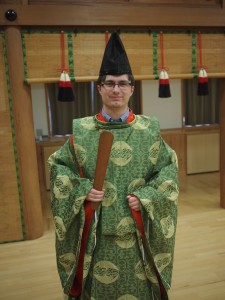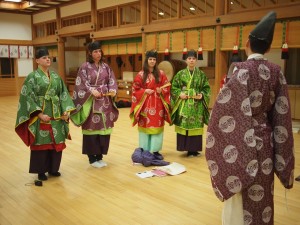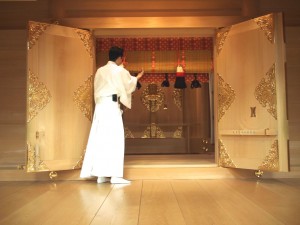Learning about Ise at Kogakkan: Day 2
Today we focused on traditional rites, shrine workers, and seasonal festivals and events. Much of what we learned can be summed up in a rare video we watched called The Heart of the Matsuri: an Invitation to Shinto. This video seems to be fairly little known even among Westerners interested in Shinto, as it only has about 10 views on YouTube. But it is quite informative so I will put it right at the top of my post. Please go ahead and watch the whole thing; I’ll be here when you get back.
Besides being a fascinating collection of real festival videos, this video shows an idealized picture of how Shinto ought to work according to Jinja Honcho, which organizes most of the shrines in the country. Of particular note is their emphasis on the ujiko system, in which people take care of shrines to which they have a blood connection — shrines connected with their historical or legendary ancestors. Because there are only 20,000 shrine workers in Japan for 80,000 shrines, Jinja Honcho likes the volunteer work done by ujiko. But in fact, despite how it is described in the video, many Japanese people are not aware of being connected with an ujigami, especially when they have moved away from their home villages.
Because the professor-priest who showed us this video was clearly involved in Jinja Honcho, I was curious and asked him what Jinja Honcho recommended for when people move from the countryside to Tokyo. He said that even if they have no uji in the area, they still have ubusuna 産土, the particular neighborhood they live in that ties them to a local kami. But he did not seem to think it plausible that people would seek out a local association to become ubuko, 産子. He said that this is something they would have to learn about by talking with local people, and so he concluded that regrettably it would be hard for urbanites to remain in this idealized Jinja Honcho system if they don’t work to create social ties binding them to their local community, kizuna 絆.
This video was from roughly 1998. We also received another, much more recent attempt to introduce Shinto to foreigners: the book Soul of Japan, produced to commemorate the 2013 shikinen sengū. This book made some headlines in the Japanese press for the fact that words like jinja and kami were officially decided to be left untranslated. However, it is only offered as a PDF and a pamphlet available in Ise itself, and you can’t really order a copy online.
Other things we did today included learning all of the annual rituals performed at the Jingū, hearing about the history of the Jingū, talking about Ise’s attempts to promote itself to foreign tourists, and dressing up in the outfit worn by shrine workers (神職) of various kinds during the most elaborate ceremonies. Here’s an embarrassing photo of myself in full shrine regalia.

It was interesting to experience wearing this kind of clothing for myself. It took about half an hour to put on, and we were instructed to handle ourselves carefully when we were walking around with it on, but once I took it off I had the distinct feeling that my Western clothing was informal and slovenly, a feeling that was shared by many of my classmates. Here’s a photo of some of my classmates being instructed in the way of doing full ritual sanpai for women.
We learned how to walk and move gracefully in a space used for practicing shrine rituals. The professor-priest showed us the difference between the worship area (拝殿 haiden) of the shrine, where people ascend a staircase and pay their respects, and the main hall (本殿 honden), which is open only to priests. When he raised the curtain and allowed us to enter the practice honden, everyone piled in and had a look around. Of course, there were no secrets there, just a table used for making offerings. The actual object representing the enshrined kami (神体 shintai) would be behind another, closed, door, which is visible in the background in this photo.
It is interesting to consider a great difference between Western and Japanese instincts in this regard. I think many Westerners get unreasonably curious about what can be found in secret places. We all want to get a peek behind the curtain. But at Ise Jingu, thousands of Japanese every day content themselves with praying to the curtain. It only costs $10 to get a special sanpai and get yourself a little closer to the honden, but very few Japanese people are interested in this. After all, the important thing is that the kami is there, not the kind of mirror or object it resides in.
Posted: February 24th, 2015 | Kogakkan


